2009 TOYOTA TUNDRA load capacity
[x] Cancel search: load capacityPage 234 of 672

234 2-4. Using other driving systems
CAUTION
Any of the following conditions may result in an accident which could cause
death or serious injury.
■The ABS does not operate effectively when
●The limits of the gripping performance have been exceeded.
● The vehicle hydroplanes while driving at high speed on the wet or slick
road.
■ Stopping distance when the ABS is operating will exceed that of nor-
mal conditions
The ABS is not designed to shorten the vehicle’s stopping distance. Always
maintain a safe distance from the vehicle in front of you in the following situ-
ations.
● When driving on dirt, gravel or snow-covered roads
● When driving with tire chains
● When driving over bumps in the road
● When driving over roads with pothol es or roads with uneven roads
■ When VSC is activated
The slip indicator flashes and a warning buzzer sounds. Always drive care-
fully. Reckless driving may cause an accident. Exercise particular care when
the indicator flashes and a buzzer sounds.
■ TRAC or A-TRAC may not operate effectively when
Directional control and power may not be achievable while driving on slip-
pery road surfaces, even if TRAC or A-TRAC is operating.
Do not drive the vehicle in conditions where stability and power may be lost.
■ Replacing tires
Make sure that all tires are of the same size, brand, tread pattern and total
load capacity. In addition, make sure that the tires are inflated to the appro-
priate tire pressure level.
The ABS and VSC will not function correctly if different tires are fitted on the
vehicle.
Contact your Toyota dealer for further information when replacing tires or
wheels.
Page 241 of 672

241
2-5. Driving information
2
When driving
Cargo and luggage
Capacity and distributionCargo capacity depends on the total weight of the occupants.
(Cargo capacity) = (Total load capacity) (Total weight of occupants)
Steps for Determining Correct Load Limit—
(1) Locate the statement “The co mbined weight of occupants and
cargo should never exceed XXX kg or XXX lbs.” on your vehicle’s
placard.
(2) Determine the combined weight of the driver and passengers that will be riding in your vehicle.
(3)Subtract the combined weight of the driver and passengers from XXX kg or XXX lbs.
(4) The resulting figure equals the av ailable amount of cargo and lug-
gage load capacity.
For example, if the “XXX” amount equals 1400 lbs. and there will
be five 150 lb passengers in your vehicle, the amount of available
cargo and luggage load capacity is 650 lbs. (1400 750 (5 150)
= 650 lbs.)
(5) Determine the combined weight of luggage and cargo being loaded on the vehicle. That weight may not safely exceed the
available cargo and luggage load capacity calculated in Step 4.
Take notice of the following information about storage precau-
tions, cargo capacity and load.
●Stow cargo and luggage in the rear deck whenever possible.
● Be sure all items are secured in place.
● Be careful to keep the vehicle level. Placing the weight as far for-
ward as possible helps maintain vehicle balance.
● For better fuel economy, do no t carry unnecessary weight.
Page 242 of 672
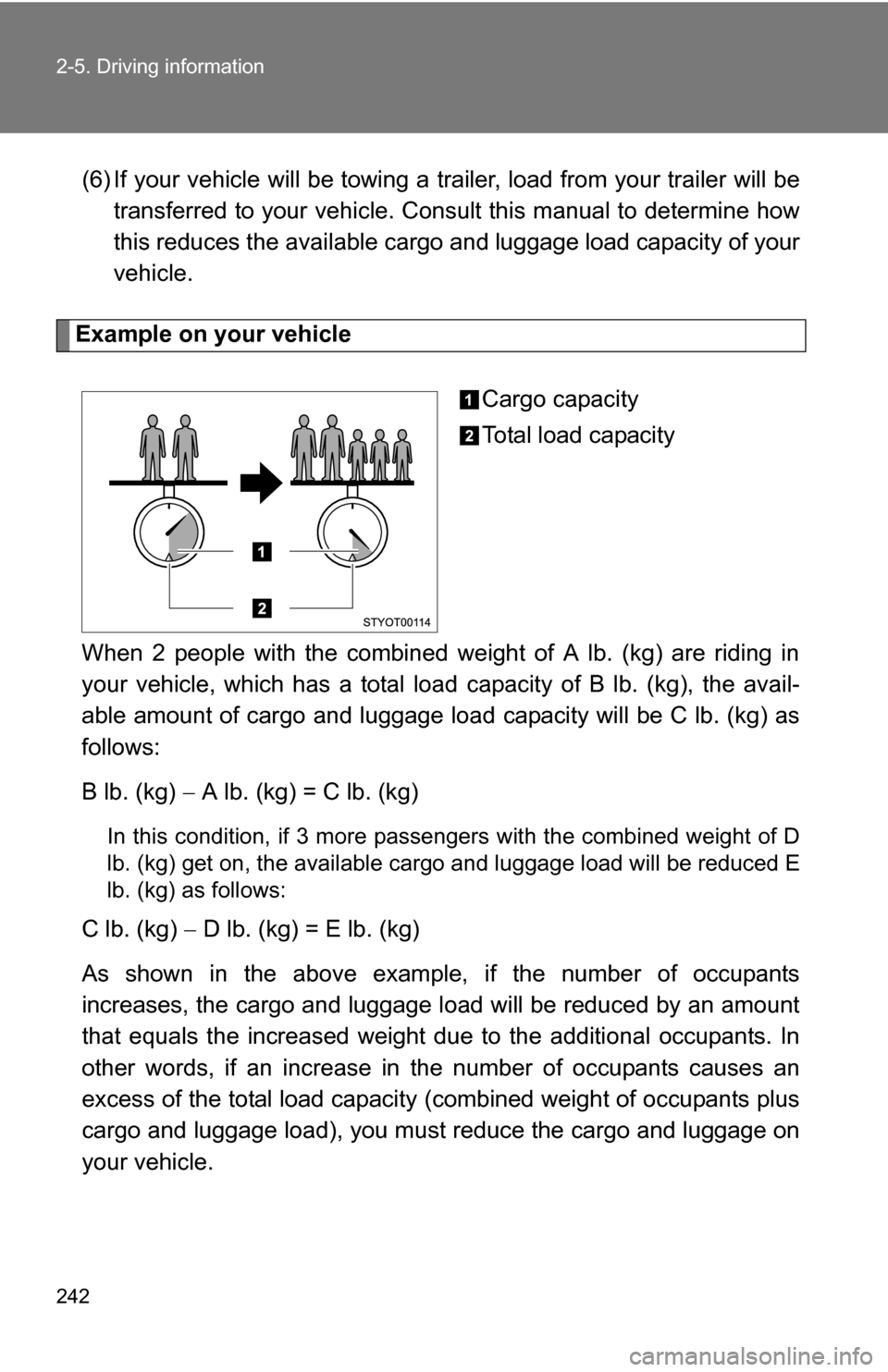
242 2-5. Driving information
(6) If your vehicle will be towing a trailer, load from your trailer will be
transferred to your vehicle. Consult this manual to determine how
this reduces the available cargo and luggage load capacity of your
vehicle.
Example on your vehicle
Cargo capacity
Total load capacity
When 2 people with the combined weight of A lb. (kg) are riding in
your vehicle, which has a total load capacity of B lb. (kg), the avail-
able amount of cargo and luggage load capacity will be C lb. (kg) as
follows:
B lb. (kg) A lb. (kg) = C lb. (kg)
In this condition, if 3 more passengers with the combined weight of D
lb. (kg) get on, the available carg o and luggage load will be reduced E
lb. (kg) as follows:
C lb. (kg) D lb. (kg) = E lb. (kg)
As shown in the above example, if the number of occupants
increases, the cargo and luggage load will be reduced by an amount
that equals the increased weight du e to the additional occupants. In
other words, if an increase in the number of occupants causes an
excess of the total load capacity (combined weight of occupants plus
cargo and luggage load), you must reduce the cargo and luggage on
your vehicle.
Page 243 of 672
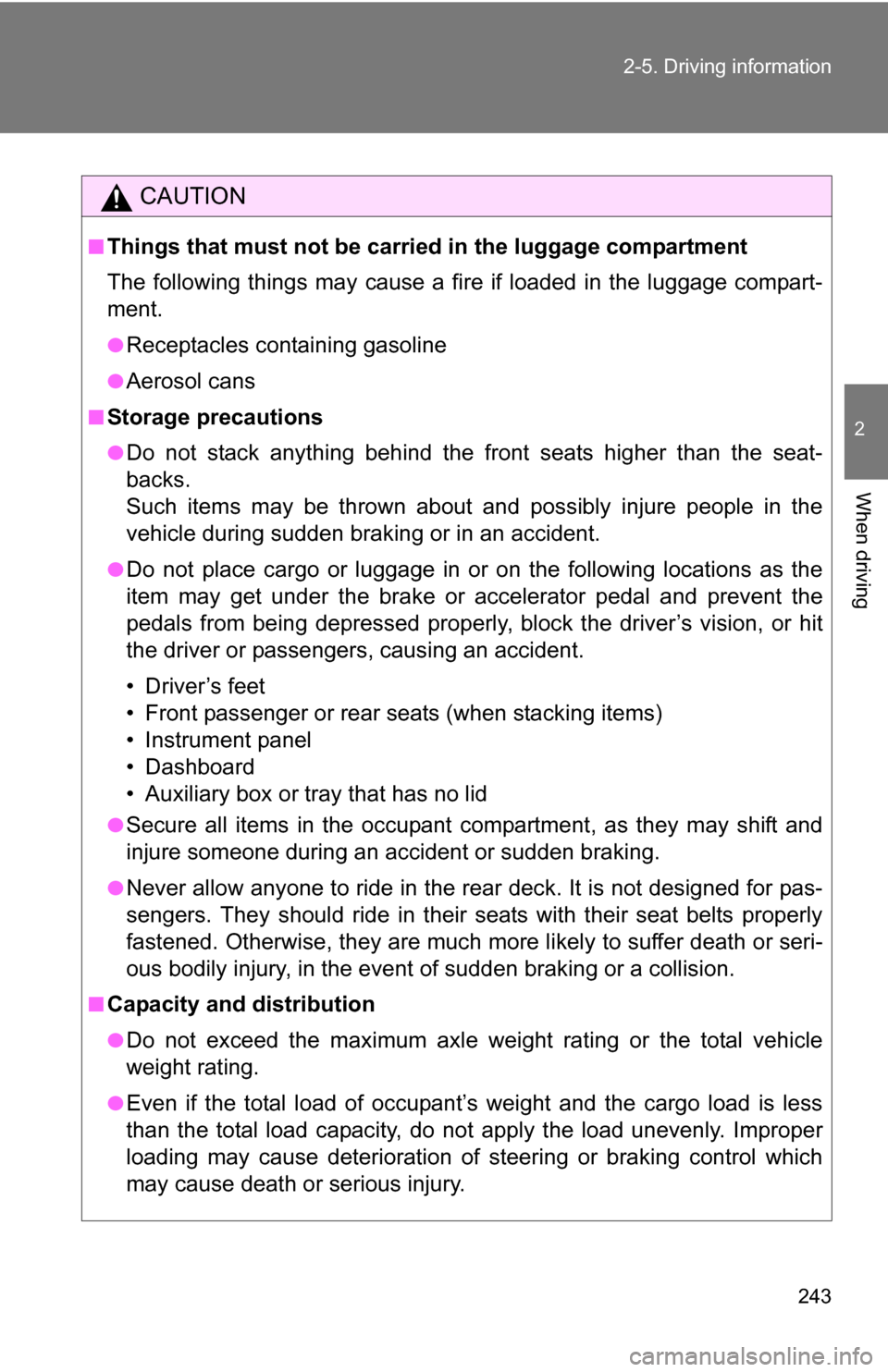
243
2-5. Driving information
2
When driving
CAUTION
■Things that must not be carried in the luggage compartment
The following things may cause a fire if loaded in the luggage compart-
ment.
●Receptacles containing gasoline
●Aerosol cans
■Storage precautions
●Do not stack anything behind the front seats higher than the seat-
backs.
Such items may be thrown about and possibly injure people in the
vehicle during sudden braking or in an accident.
●Do not place cargo or luggage in or on the following locations as the
item may get under the brake or accelerator pedal and prevent the
pedals from being depressed properly,
block the driver’s vision, or hit
the driver or passengers, causing an accident.
• Driver’s feet
• Front passenger or rear seats (when stacking items)
• Instrument panel
• Dashboard
• Auxiliary box or tray that has no lid
●Secure all items in the occupant compartment, as they may shift and
injure someone during an accident or sudden braking.
●Never allow anyone to ride in the rear deck. It is not designed for pas-
sengers. They should ride in their seats with their seat belts properly
fastened. Otherwise, they are much mo re likely to suffer death or seri-
ous bodily injury, in the event of sudden braking or a collision.
■Capacity and distribution
●Do not exceed the maximum axle weight rating or the total vehicle
weight rating.
●Even if the total load of occupant’s weight and the cargo load is less
than the total load capacity, do no t apply the load unevenly. Improper
loading may cause deterioration of st eering or braking control which
may cause death or serious injury.
Page 244 of 672
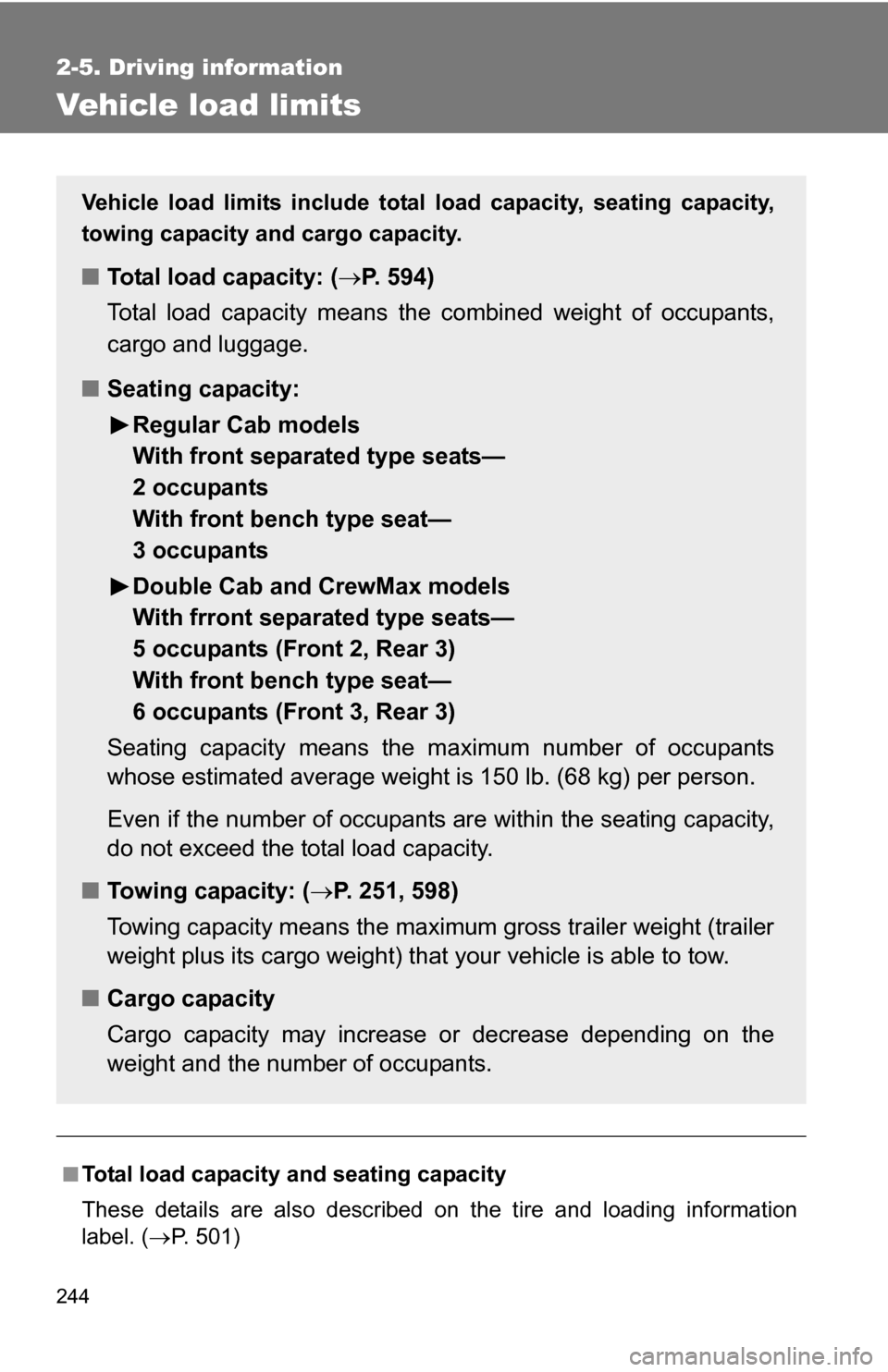
244
2-5. Driving information
Vehicle load limits
■Total load capacity and seating capacity
These details are also described on the tire and loading information
label. (P. 501)
Vehicle load limits include total load capacity, seating capacity,
towing capacity and cargo capacity.
■ Total load capacity: ( P. 594)
Total load capacity means the combined weight of occupants,
cargo and luggage.
■ Seating capacity:
Regular Cab models
With front separated type seats—
2 occupants
With front bench type seat—
3 occupants
Double Cab and CrewMax models
With frront separated type seats—
5 occupants (Front 2, Rear 3)
With front bench type seat—
6 occupants (Front 3, Rear 3)
Seating capacity means the ma ximum number of occupants
whose estimated average weight is 150 lb. (68 kg) per person.
Even if the number of occupants are within the seating capacity,
do not exceed the total load capacity.
■ Towing capacity: ( P. 251, 598)
Towing capacity means the maximum gross trailer weight (trailer
weight plus its cargo weight) that your vehicle is able to tow.
■ Cargo capacity
Cargo capacity may increase or decrease depending on the
weight and the number of occupants.
Page 251 of 672
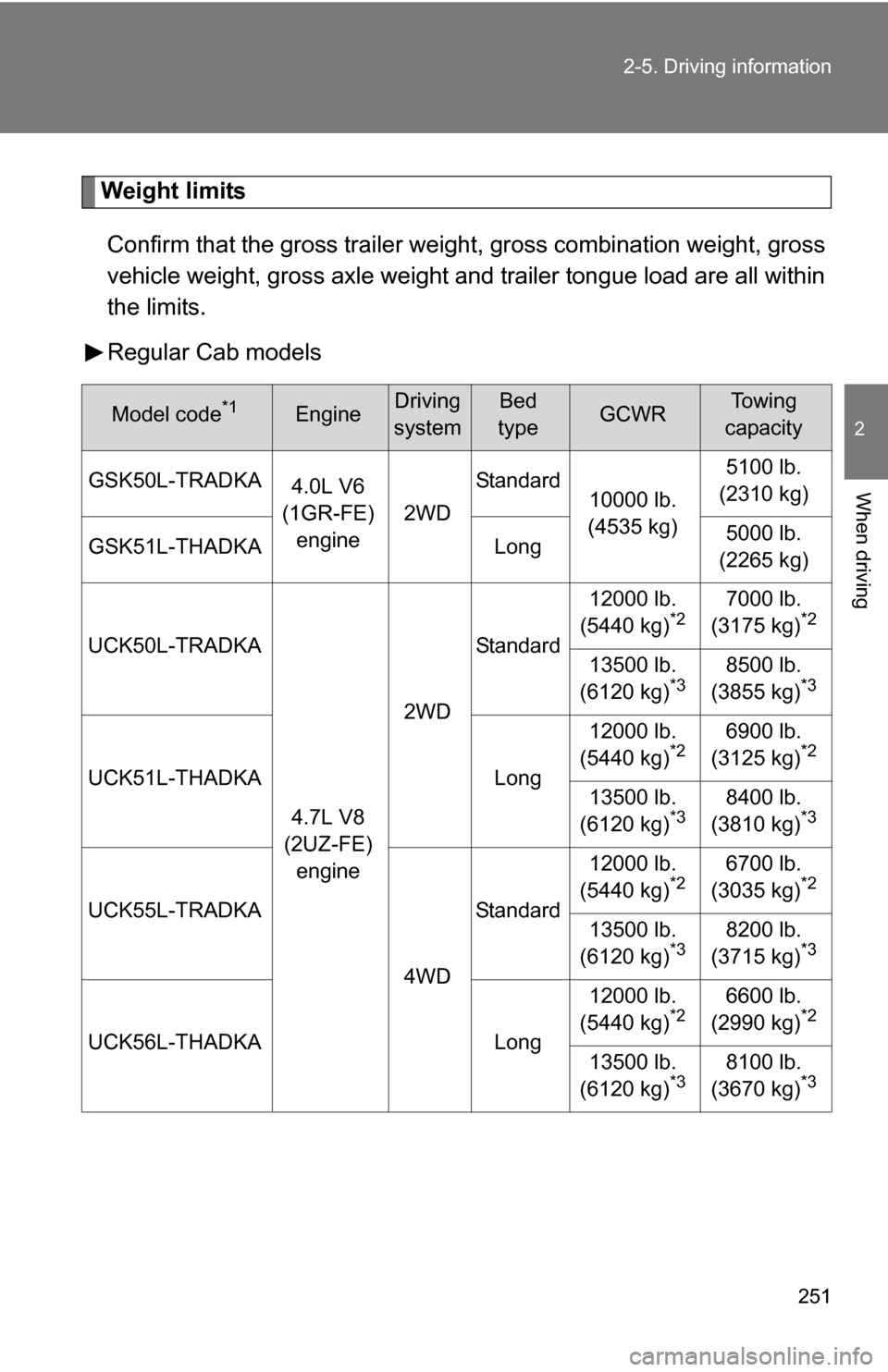
251
2-5. Driving information
2
When driving
Weight limits
Confirm that the gross trailer weight, gross combination weight, gross
vehicle weight, gross axle weight and trailer tongue load are all within
the limits.
Regular Cab models
Model code*1EngineDriving
systemBed
typeGCWRTowing
capacity
GSK50L-TRADKA 4.0L V6
(1GR-FE) engine 2WDStandard
10000 lb.
(4535 kg) 5100 lb.
(2310 kg)
GSK51L-THADKA Long 5000 lb.
(2265 kg)
UCK50L-TRADKA
4.7L V8
(2UZ-FE) engine 2WD
Standard
12000 lb.
(5440 kg)
*27000 lb.
(3175 kg)*2
13500 lb.
(6120 kg)*38500 lb.
(3855 kg)*3
UCK51L-THADKA Long12000 lb.
(5440 kg)
*26900 lb.
(3125 kg)*2
13500 lb.
(6120 kg)*38400 lb.
(3810 kg)*3
UCK55L-TRADKA
4WDStandard
12000 lb.
(5440 kg)
*26700 lb.
(3035 kg)*2
13500 lb.
(6120 kg)*38200 lb.
(3715 kg)*3
UCK56L-THADKA Long12000 lb.
(5440 kg)
*26600 lb.
(2990 kg)*2
13500 lb.
(6120 kg)*38100 lb.
(3670 kg)*3
Page 258 of 672

258 2-5. Driving information
●The gross trailer weight must never exceed towing capacity
described in the table above.
● The gross combination weight must never exceed the GCWR
described in the table above.
●The gross vehicle weight must
never exceed the GVWR indi-
cated the Certification Label.
● The gross axle weight on each
axle must never exceed the
GAWR indicated the Certifica-
tion Label.
Towing related term
Towing related termMeaning
GVWR (Gross Vehicle
Weight Rating)
The maximum allowable gross vehicle weight.
The gross vehicle weight is the total weight of
the vehicle. When towing a trailer, it is the sum
of the vehicle weight (including the occupants,
cargo and any optional equipment installed on
the vehicle) and the tongue load. (or the king
pin weight)
GAWR (Gross Axle
Weight Rating)The maximum allowable gross axle weight.
The gross axle weight is the load placed on
each axle (front and rear).
GCWR (Gross
Combination Weight
Rating)
The maximum allowabl e gross combination
weight. The gross combination weight is the
sum of the total vehicle weight (including the
occupants, cargo and any optional equipment
installed on the vehicle) and the weight of the
trailer being towed (including the cargo in the
trailer).
Gross trailer weightThe sum of the trailer weight and the weight of
the cargo in the trailer.
Page 259 of 672
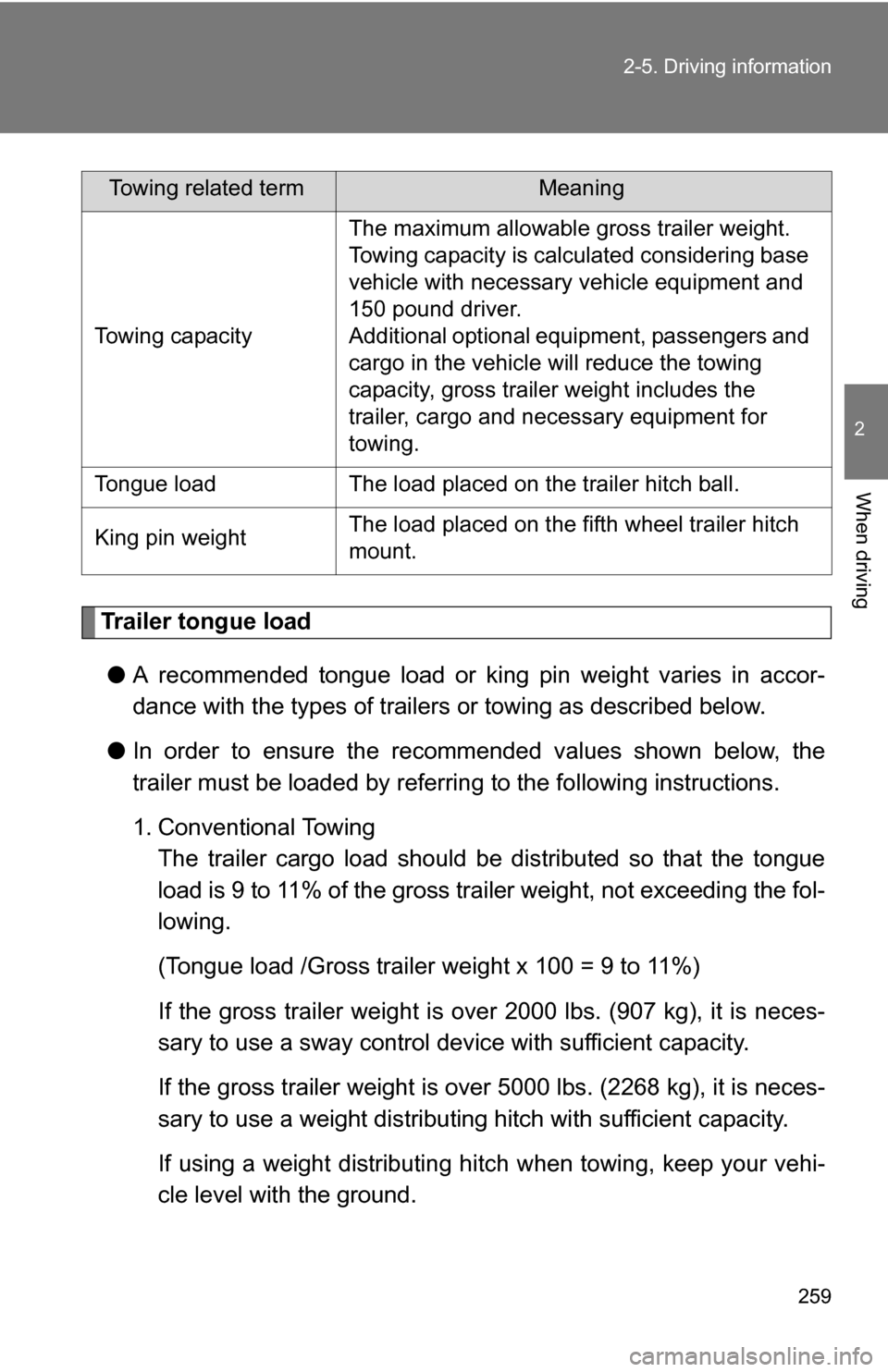
259
2-5. Driving information
2
When driving
Trailer tongue load
● A recommended tongue load or king pin weight varies in accor-
dance with the types of trailers or towing as described below.
● In order to ensure the recommended values shown below, the
trailer must be loaded by referring to the following instructions.
1. Conventional Towing
The trailer cargo load should be distributed so that the tongue
load is 9 to 11% of the gross trailer weight, not exceeding the fol-
lowing.
(Tongue load /Gross trailer weight x 100 = 9 to 11%)
If the gross trailer weight is over 2000 lbs. (907 kg), it is neces-
sary to use a sway control device with sufficient capacity.
If the gross trailer weight is over 5000 lbs. (2268 kg), it is neces-
sary to use a weight distributing hitch with sufficient capacity.
If using a weight distributing hi tch when towing, keep your vehi-
cle level with the ground.
Towing related termMeaning
Towing capacity
The maximum allowable gross trailer weight.
Towing capacity is calculated considering base
vehicle with necessary vehicle equipment and
150 pound driver.
Additional optional equipment, passengers and
cargo in the vehicle will reduce the towing
capacity, gross trailer weight includes the
trailer, cargo and necessary equipment for
towing.
Tongue loadThe load placed on the trailer hitch ball.
King pin weightThe load placed on the fifth wheel trailer hitch
mount.